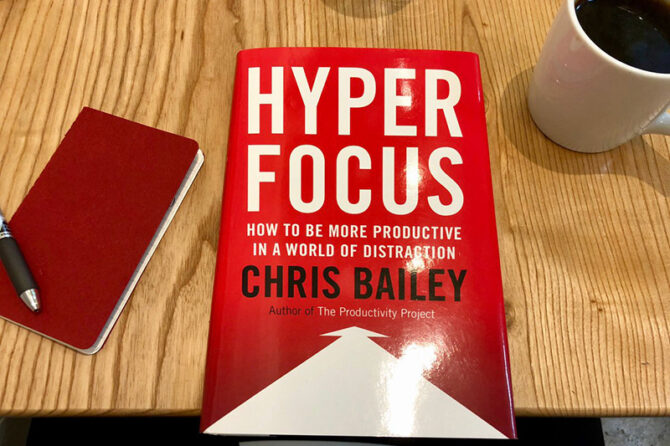
Chris Bailey, a renowned productivity expert, has carved a niche in the field of self-help and productivity with his thoughtful insights and practical advice. His first book, “The Productivity Project,” received global recognition and was translated into multiple languages, demonstrating his widespread appeal. Bailey’s work is characterized by a focus on experimental approaches to productivity, combining personal anecdotes with research findings.
In “Hyperfocus: How to Be More Productive in a World of Distraction,” Bailey tackles the universal challenge of maintaining focus in an increasingly distracted world. The book introduces two pivotal concepts: ‘Hyperfocus’ and ‘Scatterfocus.’ Hyperfocus is described as a state of deep concentration on a single task, while Scatterfocus refers to deliberately allowing the mind to wander to foster creativity.
Bailey argues that mastering these two modes of attention can drastically improve one’s productivity. He suggests various tactics for enhancing focus, such as creating distraction-free environments, managing attention effectively, and understanding the psychological underpinnings of our concentration.
While I found Chris Bailey’s “Hyperfocus” to offer a fascinating framework for understanding and controlling our attention, I have mixed feelings about how it was executed. One issue that stood out to me was the way research was presented in the book. I noticed that many of the research citations lacked depth and context, which led to a somewhat surface-level grasp of the discussed topics.
Additionally, Bailey’s style of writing didn’t always hit the mark for me. While his anecdotes were sometimes engaging, at times they felt more self-centered, reducing the book’s practical usefulness. I couldn’t help but notice phrases like “I can’t argue with this, because I don’t know the speed at which the book was written,” which seemed to underscore a dissatisfaction with Bailey’s frequent self-references and what seemed like boasting about his writing ability.
Another aspect I found problematic was the practicality and relevance of some of his advice. Suggestions like “Hit the gym or the sleeping room at your work” just didn’t seem feasible for many people, including me, who may not have such facilities available. This lack of universal practicality made the book less relevant and helpful to a wider audience.
Lastly, the book’s structure sometimes felt repetitive to me, with certain stories and phrases reappearing throughout. Instead of reinforcing the main ideas, this repetition often seemed unnecessary and redundant.

Bailey does offer some memorable quotes that succinctly capture his ideas. For instance, he writes, “All thoughts want to be taken seriously but few warrant it,” highlighting the need to be selective about where we direct our attention. This quote underscores the book’s central theme of discerning between worthy and unworthy distractions.
However, the effectiveness of such insights is arguably diluted by the book’s verbose style and the repetitive nature of some sections. As one reader points out, the book’s conclusion with the phrase “Invest your time wisely” felt ironic, given their perception of the book as a time-consuming read with limited takeaway value.
From a broader perspective, “Hyperfocus” attempts to address a pertinent issue in modern life: the challenge of staying focused amidst a myriad of distractions. Bailey’s emphasis on balancing intense focus with periods of creative wandering is an intriguing concept that aligns with contemporary understandings of cognitive flexibility and productivity.
However, the book’s impact is somewhat diminished by its presentation and style. The lack of depth in research explanation, the subjective and occasionally self-centric narrative, and the impractical nature of some advice limit its appeal and effectiveness.
For readers seeking straightforward, universally applicable advice on productivity, “Hyperfocus” might not be the ideal choice. However, for those interested in exploring different perspectives on attention management and who resonate with a more anecdotal style, Bailey’s insights could still prove valuable.
In conclusion, while “Hyperfocus” presents an interesting framework for understanding productivity and focus, its execution and relevance may not meet the expectations of all readers. Its value lies more in its conceptual exploration of focus and less in its practical applicability or research depth. As with any self-help book, its utility may vary greatly depending on the reader’s personal preferences and circumstances.

Here are 10 key takeaways from the book:
- The Concept of Hyperfocus: Hyperfocus is a state of deep, intense concentration on a single task, which can significantly enhance productivity and efficiency.
- The Role of Scatterfocus: Scatterfocus is the deliberate practice of letting the mind wander, promoting creativity and aiding in the synthesis of new ideas.
- Managing Distractions: Actively managing and reducing distractions is crucial for achieving hyperfocus. This includes tactics like putting your phone away or working in environments with fewer distractions.
- The Value of Breaks: Taking breaks and engaging in mindless activities can help recharge your attention and maintain focus over longer periods.
- Setting Clear Intentions: Before entering a state of hyperfocus, it’s important to set a clear intention or goal for what you want to achieve during that focused period.
- Attention Quality Matters: The quality of your attention is determined by how long you can focus, how quickly you recognize when your focus drifts, and how much time you spend working with intention.
- Use of Beverages for Focus and Creativity: Beverages like coffee can provide a focus boost, whereas alcohol might spur creativity due to its inhibition-lowering effects.
- The Importance of Environment: Choosing the right environment, one that minimizes potential distractions, is key to maintaining focus and productivity.
- Mindfulness in Focus: Being mindful and aware of where your attention is at any given moment can increase productivity. This involves regularly checking in with yourself to see if your current task aligns with your goals.
- Balancing Different Types of Work: Understanding and balancing different types of tasks (necessary, unnecessary, distracting, and purposeful work) can help in prioritizing and focusing on what’s most important and productive.
Prof. Dr. Prahlada N. B
14 December 2023
Chitradurga.

















Leave a reply